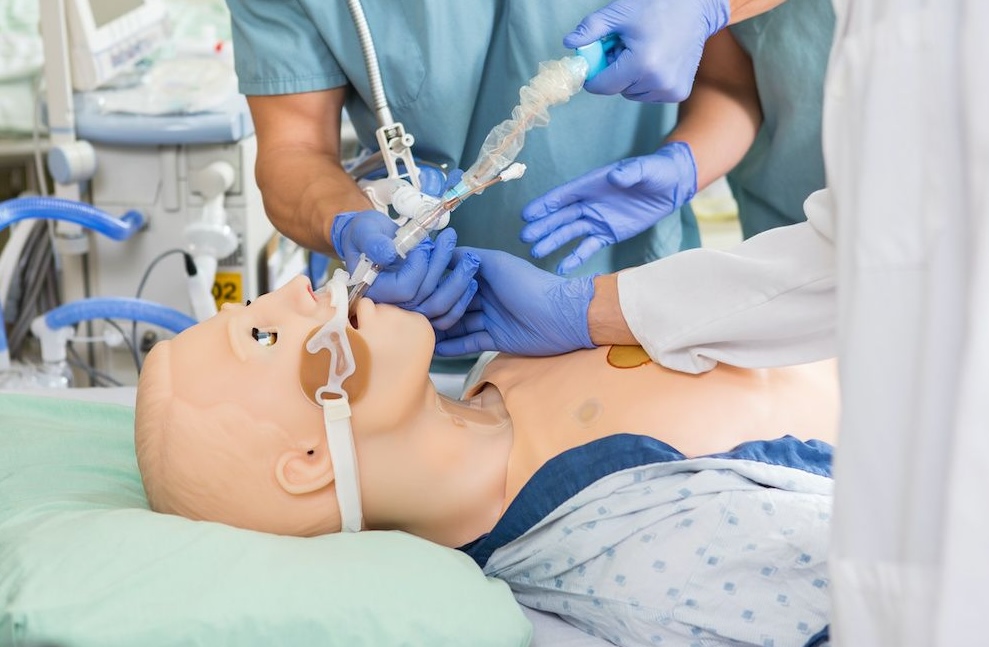Comprehensive Healthcare Simulation: Operations, Technology, and Innovative Practice is a crucial book for Medical Simulation programs looking to maximize the efficiency of their operations. From the basic theories to advanced practices, the latest healthcare simulation book has been praised by readers as a “Must Read” item for anyone operating, managing, or starting a medical simulation center. Previously we shared Chapter excerpts on “Medical Simulation Personnel“, the “Types of Healthcare Simulation” and “Medical Simulation Methodologies“, and today we take a closer look at “Finding the Right Simulation Personnel” by VA Eastern Colorado Health Care System Education and Training Instructor / Simulation Coordinator Supervisor Wendy Z. Thomson, EdD, MSN, BSBA, RN, CNE, CHSE.
The unique chapter asks “How does an organization find the right person for simulation-based education when there are few educational pathways?”, suggesting a simulation center must begin by “being deliberate, thoughtful, and clear on the who, what, and why of hiring simulation specialized personnel.”
The healthcare industry today is quite financially volatile with rapid changes in reimbursements both from private and government sectors that impact their ability to generate a profit. The cost from the point of identifying the need to hire an employee until that person is fully functioning in a productive role can cost an organization from 21% to more than one time an annual salary thus making the selection of the right person for the job extremely important. For healthcare organizations to thrive in today’s economy, finding and retaining the best employees is important, especially when competing with larger organizations with larger budgets for top talent.
When considering the fact that simulation-based education and training is mostly a non-revenue generating program with a clear cost that impacts profits, it must be asked how can healthcare organizations find the right talent for simulation- based education and training roles. Pató (2016) stated “the right employee with the right competences in the right conditions, in the right place, in the right time, at the right cost, at the right employer can bring competitiveness to the company”.
Finding, selecting, and onboarding nursing simulation personnel is no easy process, and finding someone with the right skills and qualifications should be a long-term strategy that can be tied to facility performance metrics and improved patient outcomes. How does an organization address finding the right person for simulation-based education when there are few educational pathways to identify and no standardized set of competencies to create a job description? To answer this question, a healthcare simulation center must begin by being deliberate, thoughtful, and clear on the who, what, and why of hiring simulation specialized personnel.
Staffing a clinical simulation program is no easy task. Simulation programs, large and small, can achieve greater productivity and reach their strategic goals and outcomes by properly matching an organizational structure to their mission, vision, and programmatic needs. An organizational structure delineates lines of communication, policies, authority, and responsibilities. Creating an appropriate organizational and simulation structure and function demonstrates how the roles, power, and responsibilities are assigned, controlled, and coordinated and how information will flow within the organization.
If a simulation program resides within a larger organization, then all operational activities including reporting structures and strategic plans and goal will fall within that larger organization’s business model. Therefore, it is also important to consider the needs of the larger organization when defining the required roles and job positions that will support the simulation program.
After understanding the needs of the simulation center, the organizational structure, and the needed roles, then a job analysis can begin. A job analysis is the process of understanding the requirements of the job being filled and identifying what kind of specific knowledge, skills, and abilities (KSAs) or general traits and behaviors are important to fill the position needed. The job analysis also identifies what kind of personality, experience, and education is ideal. The data from a job analysis provides information used in job descriptions, selection criteria, interview guides, and performance evaluation criteria, as well as potential pay scale or range. Failure to complete an accurate job analysis may result in an inappropriate and imprecise job evaluation, potentially leading to an employee mis- match, turnover, increased costs, and/or loss of talent.
Once the job analysis is complete, the information can be used to draft a job description. Most organizations have a job description guide or template that must be used. Involve the human resources (HR) department from the larger organization in this process if possible. HR will typically help perform the job analysis as well as facilitate translating the job analysis to an appropriate job description. A job description specifies the general responsibilities of a position along with some of the specific duties to be conducted by the role.
The title for the position and any special skills, training, or credentials required should also be listed. Since most roles and positions are unique to an organization, do not adopt preexisting job descriptions if they were not generated from a role-specific job analysis. Instead tailor the information to meet the specific needs of the position being sought.
Wendy then explores key experiences and background necessary to employ a successful simulation champion covering:
- Educational degree possibilities
- Ideal background and experiences
- Interviewing
- Legal considerations
- Known Bias indicators
More Key Take Aways From Latest Simulation Operations Book Include:
- Practical guide helps prepare professionals for the broad scope of simulation in healthcare
- Defines the domains of medical simulation operations
- Focuses on the development of the healthcare simulation technology specialist
- Written and edited by leaders in the field of clinical simulation
Written and edited by leaders in the field, Comprehensive Healthcare Simulation: Operations, Technology, and Innovative Practice is optimized for a variety of learners, including healthcare educators, simulation directors, as well as those looking to pursue a career in simulation operations as healthcare simulation technology specialists. Grab your copy today:









